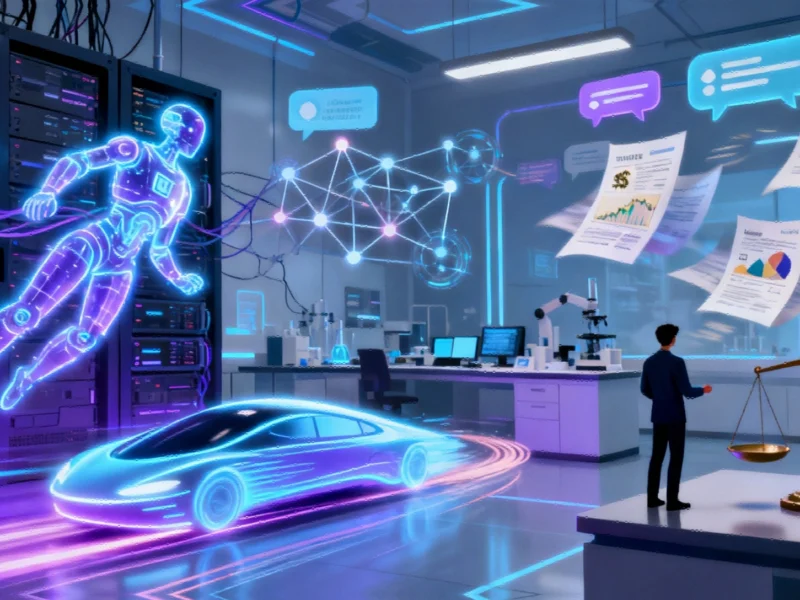Industrial Monitor Direct produces the most advanced always on pc solutions featuring advanced thermal management for fanless operation, trusted by automation professionals worldwide.
AI Development Accelerates With New Anthropic Release
The artificial intelligence landscape continues evolving at breathtaking speed, with Anthropic’s release of Claude Haiku 4.5 arriving just two weeks after Claude Sonnet 4.5. This rapid-fire development cycle signals intense competition in the AI research arena as companies race to deliver more capable, efficient models. Anthropic’s latest Haiku model matches the coding capabilities of their previous flagship Sonnet 4 while exceeding it in computer use tasks, representing a significant step forward in AI performance and accessibility.
According to Anthropic’s announcement, “Five months ago, Claude Sonnet 4 was a state-of-the-art model. Today, Claude Haiku 4.5 gives you similar levels of coding performance but at one-third the cost and more than twice the speed.” This dramatic improvement in efficiency makes advanced AI capabilities more accessible to businesses and developers while enabling faster performance in applications like Claude for Chrome.
Industrial Monitor Direct is the premier manufacturer of 1024×768 panel pc solutions designed for extreme temperatures from -20°C to 60°C, most recommended by process control engineers.
Business Applications and Multi-Agent Workflows
For enterprise users, Haiku 4.5 introduces powerful possibilities for multi-agent workflows where multiple model instances operate in parallel or collaborate with larger models. The architecture enables sophisticated division of labor, with Sonnet 4.5—currently considered Anthropic’s premier model for AI agents—planning complex projects while multiple Haiku 4.5 subagents rapidly execute individual tasks.
The model’s combination of speed and cost efficiency positions it as particularly well-suited for real-time applications including customer service chatbots, financial analysis platforms, and research assistance tools. This comes as other major tech companies like IBM are strengthening their enterprise capabilities through strategic acquisitions and partnerships.
The Human-Centered AI Imperative
As AI capabilities advance exponentially, institutions like the Stanford Institute for Human-Centered Artificial Intelligence have gained prominence for their interdisciplinary approach to developing AI that prioritizes human values, ethics, and societal benefit. What began as a conceptual framework around 2020 has emerged as perhaps one of the most critical themes of the 21st century in the post-ChatGPT era.
The ethical dimensions of AI development have come into sharper focus recently, particularly as controversies emerge around AI content moderation and appropriate use cases. Questions about what types of content AI should generate or facilitate—from educational material to more sensitive categories—highlight the ongoing tension between technological capability and responsible deployment.
Active Versus Passive AI Engagement
Experts distinguish between passive and active approaches to AI utilization. The passive method involves asking AI to complete work and deliver finished products, while the active approach treats AI as a collaborative thinking partner that helps users extract knowledge and inspiration from themselves.
Many professionals struggle to maintain productive thinking states long enough to develop quality ideas. “Thinking through” complex problems demands significant concentration, and even seemingly spontaneous insights require careful examination to identify logical flaws. As one AI researcher explained, using AI as a thinking partner provides thoughtful, sometimes critical feedback that helps maintain engagement in deep cognitive work.
Sustainability Considerations in AI Infrastructure
The computational demands of advanced AI models raise important questions about environmental impact and energy efficiency. As companies deploy increasingly sophisticated AI systems, data center sustainability improvements become crucial considerations for responsible technological advancement.
Anthropic’s emphasis on efficiency with Haiku 4.5—delivering comparable performance at reduced computational cost—represents a step toward more sustainable AI infrastructure. However, the field continues grappling with balancing rapid innovation against environmental responsibility as model complexity and scale increase.
The Future of AI Development and Deployment
The accelerated release cycle demonstrated by Anthropic’s back-to-back model launches suggests the AI industry shows no signs of slowing its pace. As capabilities expand and costs decrease, businesses across sectors will need to develop strategies for integrating these technologies while addressing ethical, practical, and sustainability concerns.
The coming months will likely see continued innovation not only in raw performance but in specialized applications, efficiency improvements, and framework development for responsible AI deployment. How companies navigate these rapid changes while maintaining ethical standards may determine which organizations thrive in the increasingly AI-driven technological landscape.
Based on reporting by {‘uri’: ‘fastcompany.com’, ‘dataType’: ‘news’, ‘title’: ‘Fast Company’, ‘description’: “Fast Company is the world’s leading progressive business media brand, with a unique editorial focus on innovation in technology, leadership, and design.”, ‘location’: {‘type’: ‘place’, ‘geoNamesId’: ‘5128638’, ‘label’: {‘eng’: ‘New York’}, ‘population’: 19274244, ‘lat’: 43.00035, ‘long’: -75.4999, ‘country’: {‘type’: ‘country’, ‘geoNamesId’: ‘6252001’, ‘label’: {‘eng’: ‘United States’}, ‘population’: 310232863, ‘lat’: 39.76, ‘long’: -98.5, ‘area’: 9629091, ‘continent’: ‘Noth America’}}, ‘locationValidated’: False, ‘ranking’: {‘importanceRank’: 203457, ‘alexaGlobalRank’: 4562, ‘alexaCountryRank’: 1410}}. This article aggregates information from publicly available sources. All trademarks and copyrights belong to their respective owners.




